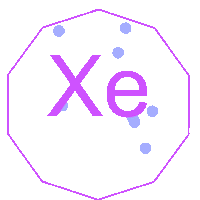Xenon

Xenon (Xe)
General Information
- Symbol: Xe
- Atomic Number: 54
- Atomic Weight: 131.293 u
- Element Category: Noble gas
- Group: 18
- Period: 5
- Block: p-block
Physical Properties
- Appearance: Colorless, dense, odorless gas
- Density: 5.894 g/L at STP
- Melting Point: -111.8 °C (-169.2 °F)
- Boiling Point: -108.1 °C (-162.6 °F)
- Phase at STP: Gas
- Electron Configuration: [Kr] 4d¹⁰ 5s² 5p⁶
- Oxidation States: 0 (most common), +2, +4, +6, +8 (rare and in compounds)
Chemical Properties
- Reactivity: Generally unreactive, but can form compounds under specific conditions, particularly with fluorine and oxygen.
- Compounds: Forms compounds such as xenon hexafluoride (XeF₆), xenon tetroxide (XeO₄), and xenon difluoride (XeF₂).
Uses and Applications
- Lighting: Used in flash lamps, high-intensity discharge lamps, and certain types of arc lamps due to its ability to produce bright light.
- Medical Imaging: Used as a contrast agent in imaging studies, particularly in CT scans and MRI scans.
- Anesthesia: Employed as a general anesthetic in specific medical procedures due to its anesthetic properties.
- Space Propulsion: Utilized in ion propulsion systems for spacecraft due to its inertness and high atomic weight.
- Nuclear Energy: Used in bubble chambers and other types of radiation detectors.
Occurrence and Extraction
- Natural Occurrence: Found in trace amounts in the Earth’s atmosphere (about 0.0000087% by volume).
- Extraction: Extracted commercially through the fractional distillation of liquid air.
Isotopes
- Stable Isotopes: Xenon-124, Xenon-126, Xenon-128, Xenon-129, Xenon-130, Xenon-131, Xenon-132, Xenon-134, Xenon-136
- Radioactive Isotopes: Xenon-133 (used in medical imaging) and several others used in scientific research and nuclear reactors.
Safety and Handling
- Hazards: Generally non-toxic and inert. However, xenon compounds, particularly fluorides, can be highly reactive and toxic.
- Precautions: Handle xenon compounds with care, using appropriate protective equipment to avoid exposure.
History
- Discovery: Discovered by William Ramsay and Morris Travers in 1898.
- Name Origin: Derived from the Greek word “xenos,” meaning “strange” or “foreign.”
Additional Facts
- Crystal Structure: Face-centered cubic (fcc) in solid form
- Magnetic Properties: Diamagnetic
- Thermal Conductivity: Low, about 0.00565 W/m·K
- Electrical Resistivity: Non-conductive in its elemental form
Summary
Xenon is a noble gas known for its applications in lighting, medical imaging, anesthesia, and space propulsion. It is generally unreactive but can form compounds with fluorine and oxygen under specific conditions. Found in trace amounts in the atmosphere, xenon is extracted through fractional distillation of liquid air. Its stable isotopes and inertness make it valuable in various high-tech and medical fields.
40 Question and Answer Pairs About Xenon
What is the atomic number of Xenon?
- 54
What is the symbol for Xenon?
- Xe
What is the atomic weight of Xenon?
- 131.293 u
In which group of the periodic table is Xenon found?
- Group 18
What period is Xenon in?
- Period 5
What block does Xenon belong to?
- p-block
What is the melting point of Xenon?
- -111.8 °C (-169.2 °F)
What is the boiling point of Xenon?
- -108.1 °C (-162.6 °F)
What is the density of Xenon at STP?
- 5.894 g/L
What is the electron configuration of Xenon?
- [Kr] 4d¹⁰ 5s² 5p⁶
What are the common oxidation states of Xenon?
- 0, +2, +4, +6, +8
What is the appearance of Xenon?
- Colorless, dense, odorless gas
Is Xenon reactive with air?
- Generally unreactive, but can form compounds under specific conditions
Name a compound of Xenon.
- Xenon hexafluoride (XeF₆)
What is a common use of Xenon in lighting?
- Used in flash lamps and high-intensity discharge lamps
How is Xenon used in medical imaging?
- As a contrast agent in CT scans and MRI scans
What role does Xenon play in anesthesia?
- Used as a general anesthetic in specific medical procedures
How is Xenon used in space propulsion?
- In ion propulsion systems for spacecraft
What application does Xenon have in nuclear energy?
- Used in bubble chambers and radiation detectors
Where is Xenon naturally found?
- In trace amounts in the Earth’s atmosphere
How is Xenon extracted from the atmosphere?
- Through fractional distillation of liquid air
What is the most stable isotope of Xenon?
- Xenon-132
Name a radioactive isotope of Xenon used in medical applications.
- Xenon-133
What safety hazard is associated with Xenon compounds?
- Xenon compounds, particularly fluorides, can be highly reactive and toxic
Who discovered Xenon?
- William Ramsay and Morris Travers
Where does the name Xenon come from?
- From the Greek word “xenos,” meaning “strange” or “foreign”
What is the crystal structure of Xenon in solid form?
- Face-centered cubic (fcc)
Is Xenon paramagnetic or diamagnetic?
- Diamagnetic
What is the thermal conductivity of Xenon?
- About 0.00565 W/m·K
What is the electrical resistivity of Xenon in its elemental form?
- Non-conductive
What is the primary oxidation state of Xenon in compounds?
- +2, +4, +6
Is Xenon found as a free element in nature?
- Yes, in trace amounts in the atmosphere
What is the common name of xenon difluoride?
- XeF₂
What is a major application of xenon hexafluoride (XeF₆)?
- Used in the synthesis of other xenon compounds
How does Xenon benefit space propulsion?
- Provides efficient ion propulsion for spacecraft
What is the boiling point of Xenon in Kelvin?
- 165.1 K
What group does Xenon belong to in the periodic table?
- Noble gases
What is the natural abundance of Xenon-132?
- About 26.89%
Can Xenon be used in high-temperature applications?
- Yes, in specific ion propulsion systems and lighting applications
What is the key property that makes Xenon valuable in medical imaging?
- Its ability to act as a contrast agent due to its density and inertness






